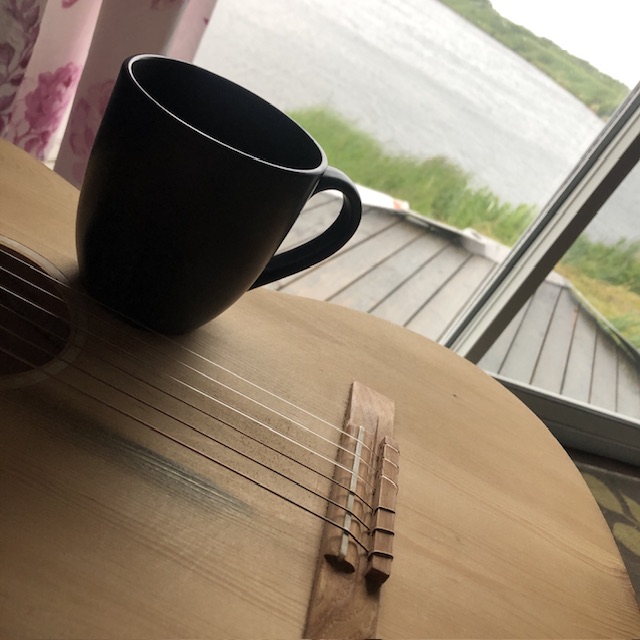|
Firefrets -> RE: Restoration of a 100 year old Flamenco (Jun. 28 2025 11:48:50)
|
Let's talk a bit more about the bridge...
I'd deliberately left deciding what to do with the bridge until I'd fully constructed the guitar. The problem is until I have the guitar under full string tension, I really can't test anything properly, and this is very different than setting the neck angle in a solera, and having a bone saddle that I can adjust.
I've a guitar that needs reassembling, tuning pegs fitting, and she's going to settle however she settles once under tension. Rebuilding and replacing the back is going to change things slightly in terms of angle, and so I had to use a degree of guess work in the reassembly. I have no room for adjustment at the saddle, so I needed to put everything in a good ball park.
I'd decided that the best way to proceed was to simply re-build the guitar, and then assess. If I touched the bridge too soon, I could end up having a major headache, if my judgement was off, so patience was needed. However, I also didn't want to lose a few weeks of down time choosing and waiting for pegs to arrive etc.
After much deliberation, I decided to introduce a fret saddle.
In order to make this work, I'd need to remove the bridge for a second time, remove the frets, and exaggerate the neck angle slightly. This would allow me to reduce the height of the bridge, which was 10mm, and if the guitar Gods were on my side, I'd be able to make the guitar intonate very well.
It was a big decision, as in front of me, I had a guitar that played absolutely perfectly, with low flamenco action, as I'd absolutely nailed it all with a view to keeping the bridge original. Guitars were played differently 100 years ago, and super low flamenco bridges weren't really a thing back then, or at least the ones I've studied weren't. But the way we play now has changed, so I wanted to find a happy compromise.
BAD STRINGS ...
I'd done an awful lot of testing prior, to see if I could actually get this to work, but when I tested everything for a final time before committing, I noticed the G string was ridiculously out. "This can't be right" I told myself. I decided to stop, take a step back, and trust myself to come up with a solution the following day. I remembered having difficulties intonating an electric guitar some 20 years ago, when it struck me that perhaps the string might be faulty ... and sure enough, it was!
I replaced the string, and the whole guitar intonated perfectly. Finally the guitar had stopped fighting me, and like trying to tame a wild horse, she had accepted me. I constantly remind a guitar that I need their help if I'm going to be able to save them. I'll sometimes thank them, or even scold them. You might think I'm crazy, but I do ha ha. I'll bet if builders are honest they often talk to their guitars too.
I'm in a luthier forum, so don't need to elaborate on finding the right position for the bridge etc, or changing the neck angle etc. This isn't teaching, just sharing work, and builders already know their stuff, or at least enough. Sure, I had to carve the bridge a little, but I think it was the right decision. Now, the top of the saddle fret on the treble side is 8.5mm, and so she's offering just under 9mm at the bridge which is absolutely fantastic, as well within flamenco spec.
Once again, I had to ensure I didn't mess up, as there is no room for error on the action, but I'm delighted to say that when the guitar was finished, I'd made some great calculations, and she is 3mm at the bass and 2.5mm at the treble, and intonates wonderfully. You wouldn't think it's possible without having different intonation points, but it is.
He who dares etc.
[img]https://live.staticflickr.com/65535/54619194830_1b908e6b3a_b.jpg[/img]
[img]https://live.staticflickr.com/65535/54619087474_ef9b169ae8_b.jpg[/img]
[img]https://live.staticflickr.com/65535/54619102928_61c39bacbd_b.jpg[/img]
[img]https://live.staticflickr.com/65535/54618883796_35f89687e8_b.jpg[/img]
[img]https://live.staticflickr.com/65535/54618883766_ea798c0407_b.jpg[/img]
[img]https://live.staticflickr.com/65535/54619102883_e7d0e52280_b.jpg[/img]
[img]https://live.staticflickr.com/65535/54619194710_540dc0260f_b.jpg[/img]
[img]https://live.staticflickr.com/65535/54618003137_ae9d54e612_b.jpg[/img]
[img]https://live.staticflickr.com/65535/54619087394_434f4ca7c1_b.jpg[/img]
[img]https://live.staticflickr.com/65535/54619194675_a7e47f653d_b.jpg[/img]
[img]https://live.staticflickr.com/65535/54619102843_fbf7f4b4e2_b.jpg[/img]
[img]https://live.staticflickr.com/65535/54619087369_84f949d3e0_b.jpg[/img]
[img]https://live.staticflickr.com/65535/54619087374_ac6fb11ffd_b.jpg[/img]
|
|
|
|

